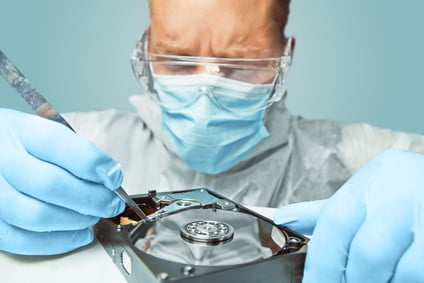
Data Recovery Technician.
Data recovery is the method by which raw data is moved from an unreadable device to a secondary storage medium in order to retain the fidelity of the data so that it can be used again. It is usually needed when a particular storage device fails in operation and the data on the device is needed to perform mandatory tasks. Data recovery can be done on discs that have met with an untimely demise via software or hardware failure. However, it cannot be done on drives that have been physically damaged beyond a certain point. Most data recovery is done on devices that are impossible to access or have minor damage in their input/output process. Many software companies provide end-user solutions to the problem of data recovery. These usually stem from a problem in the booting of an operating system or a flaw in the boot partition. When discussing data recovery, it is integral to note that this process occurs in a series of logical steps.
Data Recovery Tools, Step One, Reconnaissance.
To determine how to go about a professional data recovery process, you must first appreciate the problem that the system is facing. To do this, you have to isolate the possible culprits and find which one is causing the problem with the drive or storage medium. Once that is determined, then you can move on to a casual inspection of the depth of damage done. Sometimes it can be impossible to recover data from a disc because it is too badly damaged physically. It is easy to spot discs like these and write them off as a lost cause. Once you determine the depth of damage, you can proceed to examine the host machine to ascertain whether the problem is likely to occur again if a new drive is connected. Sometimes, the host machine’s connections or voltages are far in excess of what is required to run the disc and the excess voltage can lead to the destruction of the disc over time. Spotting this allows you to correct for it before a new drive is put in. Consulting the disc itself, you can get a feel for the amount of data that is on it, and the type and importance of the lost data to know where to begin recovery. Finally, you should check the state and availability of backups, since these can be essential in verifying the correctness of recovered data.
Step Two – Usable Resources.
In order for a recovery to proceed properly, it requires the correct type of resources, both human and non-human. Generally a working system to run the recovery of the drive on is a must, as is the tools required to mount the drive in a safe and accessible location. These professional tools include the connections for powering the drives as well as whatever cables and mounting screws are necessary. Ideally, you can ask for assistance from a computer storage restoration expert like eProvided, since they have experience in a wide array of matters that the everyday user will probably be unaware of. Before mounting the disc, however, you should be aware of the location that the recovered files are to go to. Ideally, recovered files go to a drive that is at least twice as big as the original drive from which the data is being recovered. This is to ensure that space does not run out before recovery finishes.
Step Three – Isolate.
Chances are you’re going to enlist the aid of a data recovery expert. One of the key things that you must avoid doing is installing recovery software on the damaged drive. In fact, anything that writes to the damaged drive is a definite no. Because of the nature of the damage, writing information to the drive can corrupt the information already on the drive further. This can lead to added complications when recovering the data at a later time. Discs usually keep information about what is written where in their table of contents, and data isn’t usually erased when rewritten, the information from the file table is simply deleted and a new set of information is written in its place. By installing a file recovery system on the damaged disc, you risk rewriting data that you would need to recover.
Professional data recovery is something a computer owner must go through at some point in his life. Hard drives are notorious for failing without prior warning. However, if your hard drive makes noise when it boots up, it’s probably a good idea to consider backing the data from that drive up and buying a new one to replace it. Taking precautions such as these can lower your need for file recovery but it will never remove the need altogether. Data recovery is a part of owning a computer. Some involved recovery methods need specific tools in order to access information on damaged drives. Most times, however, a recovery expert will be able to have you up and running in a few hours, depending on how extensive the damage is and how recoverable the files you need are.
